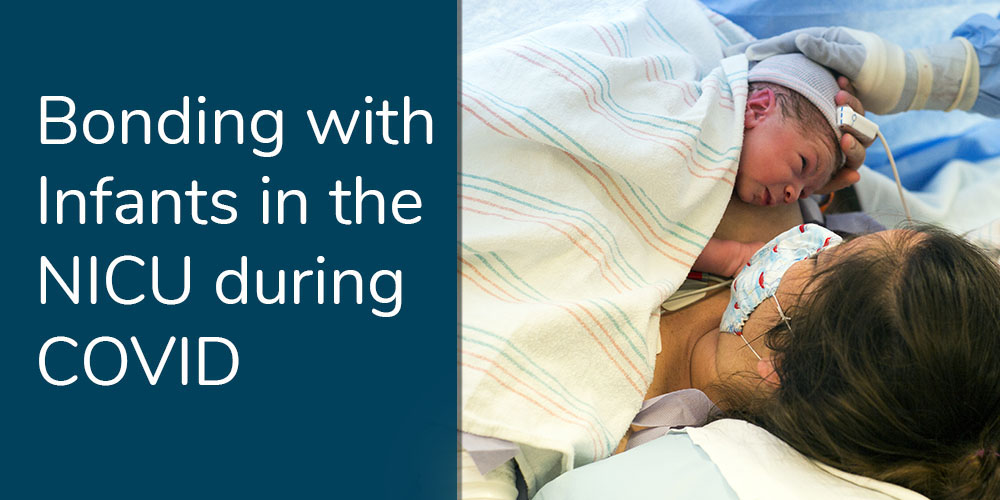 Filed Under: NICU
Filed Under: NICUBonding with Infants in the NICU during COVID

Bonding with a newborn after delivery is more than a sacred maternal rite of passage. Those first moments and the days that follow the delivery form a strong attachment between newborns and parent(s) or primary caregiver. Even when medical care interrupts this bonding process, smiling faces establish a deep human connection for the infant to feel she is welcome in this world.
NICU Infants Need Faces
Mask-wearing during the pandemic has upset this delicate bonding. Newborns are wholly dependent on their parents and quickly learn to recognize them. Research shows that newborns prefer looking at faces, especially familiar faces where a close connection exists.
For infants and children to feel safe, they use facial cues to regulate their nervous systems and identify threatening situations. If this “attachment” does not occur, the infant or child can feel anxious and unsure of their environment. This early-development anxiety can create patterns that continue throughout life.
Attachment Theory with Newborns
British psychologist John Bowlby was the first attachment theorist, describing attachment as a “lasting psychological connectedness between human beings.”1 Bowlby was interested in understanding the separation anxiety and distress children experience when separated from their primary caregivers.
Studies related to bonding and attachment eventually led to the modern hospital practice of bringing mothers and infants together with skin-to-skin contact as soon as possible after birth. As strange as it sounds, mom and infant “rooming-in” together is a relatively recent practice. In the 1950s, when home births gave way to a preference for hospital births, nurses separated mothers from their infants to promote sleep and rest.2
Balancing Nurture with Mask Wearing
Today we understand that soon after birth, the mother and infant get to know each other, and the potential for a strong bond starts developing. During this initial stage of growth, the infant’s neurons undergo extraordinary development. Within three months, the brain has grown to half of its adult size and will double in the first year.3 Even Charles Darwin felt that our ability to read facial expressions gives us an evolutionary advantage by aiding social interaction and harmonious living.4 He dutifully recorded every gesture and grimace of his newborns in his notebook:
“Six weeks and 4 days, smiled repeatedly, and I think chiefly when suddenly seeing the face of mother and mine.”5
Balancing Nurture with Mask Wearing
For families with infants in the NICU, the breach of bonding can be a traumatic experience for everyone involved – especially when the mask covers facial features that communicate a sense of safety and love.
Health professionals should understand that the need for bonding goes beyond the initial skin-to-skin embrace. Face recognition settles the nervous system and creates a sense of safety during a time of profound brain growth. Innovation can assist in balancing the requirement to wear masks with the need to optimize the infants’ and parents’ psychological outcomes should be encouraged.
Creative Options for Masks
At Oregon Health & Science University (OHSU), nurse Mollie Poor became concerned that NICU infants would not see caregiver faces during stays that could last several months. Mollie told OHSU News, “So much of how infants learn is by copying the expressions of those around them. When I saw in a COVID-19 update that we had clear masks available, I knew I needed to fight for our families to get them.”
The new NICU mask contains a clear plastic shield that covers nose and mouth but offers two foam strips to create a tight shield. The masks can be re-used by the same person after disinfection.
“I’ve already seen so many happy parents whose babies finally get to see their faces,” Mollie Poor said. “It’s been so rewarding for me to see the big smiles on a mom’s face as she breastfeeds her infant or a dad doing his first diaper change with the mask.”6
Steps Health Professionals can Take
Acta Paediatrica, a peer-reviewed journal at the forefront of pediatric research, published a series of steps that neonatal units should take to promote maternal attachment. Here are some highlights:7
Access and role of parents
- Both parents or caregivers must have access to infants. Participation in care and skin‐to‐skin contact should be welcomed and supported. Psychological support should be provided for parents.
Respect for infection barriers
- Current protocols should be observed, including washing hands, distancing, surgical masks, hand sanitizer before contact with infant, monitoring for COVID symptoms, respect for quarantines, and other common steps.
Developmental care
- The infant attachment should be nurtured through early and prolonged skin‐to‐skin contact, adapted sound and light levels, flexed posture, protected sleep periods, and prevention and treatment of pain.
- When a parent has COVID, offer NICU access for another identified caregiver until that parent is deemed safe to visit. Consider deploying technology so the family can see the infant when unable to visit.
With so much necessary attention on mask-wearing during the pandemic, commensurate attention should support the infant’s development. Finding solutions is a challenge, but creative efforts and developmental awareness can strike the necessary balance.
- Bowlby, J. (1969). Attachment and loss. (OKS Print.) New York: Basic Books.
- www.ncbi.nlm.nih.gov/pmc/articles/PMC6353266/
- Holland D. and all. Structural growth trajectories and rates of change in the first 3 months of infant brain development. JAMA Neurol. 2014;71(10):1266–1274.
- Darwin C. Oxford University Press; Oxford: 1872. The Expression of the Emotions in Man and Animals.
- undark.org/2017/11/03/wilo-darwin-evolution/
- news.ohsu.edu/2020/09/15/seeing-smiles-in-the-neonatal-intensive-care-unit
- onlinelibrary.wiley.com/doi/10.1111/apa.15455






 Prev
Prev